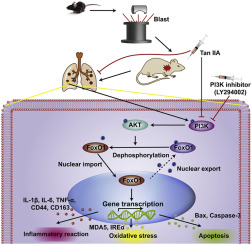当前位置:
X-MOL 学术
›
Free Radical Bio. Med.
›
论文详情
Our official English website, www.x-mol.net, welcomes your
feedback! (Note: you will need to create a separate account there.)
Tanshinone IIA alleviates blast-induced inflammation, oxidative stress and apoptosis in mice partly by inhibiting the PI3K/Akt/FoxO1 signaling pathway.
Free Radical Biology and Medicine ( IF 7.1 ) Pub Date : 2020-03-01 , DOI: 10.1016/j.freeradbiomed.2020.02.032 Yunen Liu 1 , Changci Tong 1 , Yushan Tang 2 , Peifang Cong 1 , Ying Liu 1 , Xiuyun Shi 1 , Lin Shi 1 , Yan Zhao 3 , Hongxu Jin 1 , Jing Li 4 , Mingxiao Hou 1
Free Radical Biology and Medicine ( IF 7.1 ) Pub Date : 2020-03-01 , DOI: 10.1016/j.freeradbiomed.2020.02.032 Yunen Liu 1 , Changci Tong 1 , Yushan Tang 2 , Peifang Cong 1 , Ying Liu 1 , Xiuyun Shi 1 , Lin Shi 1 , Yan Zhao 3 , Hongxu Jin 1 , Jing Li 4 , Mingxiao Hou 1
Affiliation

|
Although Tanshinone IIA (Tan IIA) has been associated with inflammation, oxidative stress and apoptosis, the effects of Tan IIA on lung blast injury remain uncertain. In this study, we explored the effects of Tan IIA on lung blast injury, studied its possible molecular mechanisms. Fifty C57BL/6 mice were randomly divided into the control, blast, blast + Tan IIA, blast + LY294002 (a PI3K inhibitor), or blast + Tan IIA + LY294002 groups. Serum and lung samples were collected 48 h after blast injury. The data showed that Tan IIA significantly inhibited blast-induced increases in the lung weight/body weight and wet/dry (W/D) weight ratios, decreased the CD44-and CD163-positive inflammatory cell infiltration in the lungs, reduced the IL-1β, TNF-α and IL-6 expression, and enhanced IL-10 expression. Tan IIA also significantly alleviated the increases in MDA5 and IRE-a and the decrease in SOD-1 and reversed the low Bcl-2 expression and the high Bax and Caspase-3 expressions. Additionally, Tan IIA significantly decreased p-PI3K and p-Akt expression and increased p-FoxO1 expression. More importantly, both LY294002 and Tan IIA pretreatment markedly protected against blast-induced inflammation, oxidative stress and apoptosis in lung blast injury. These results suggest that Tan IIA protects against lung blast injury, which may be partly mediated by inhibiting the PI3K/Akt/FoxO1 signaling pathway.
中文翻译:

丹参酮IIA可部分抑制PI3K / Akt / FoxO1信号通路,从而减轻小鼠胚细胞诱发的炎症,氧化应激和细胞凋亡。
尽管丹参酮IIA(Tan IIA)与炎症,氧化应激和细胞凋亡相关,但Tan IIA对肺胚细胞损伤的影响仍不确定。在这项研究中,我们探索了Tan IIA对肺胚细胞损伤的影响,研究了其可能的分子机制。将五十只C57BL / 6小鼠随机分为对照组,blast,blast + Tan IIA,blast + LY294002(PI3K抑制剂)或blast + Tan IIA + LY294002组。爆炸损伤后48小时收集血清和肺样品。数据显示,Tan IIA显着抑制了胚泡诱导的肺重量/体重和湿/干(W / D)重量比的增加,减少了肺中CD44和CD163阳性炎症细胞浸润,降低了IL- 1β,TNF-α和IL-6表达,以及IL-10表达增强。Tan IIA还显着减轻了MDA5和IRE-a的增加以及SOD-1的减少,并逆转了低Bcl-2表达以及高Bax和Caspase-3表达。此外,Tan IIA显着降低p-PI3K和p-Akt表达,并增加p-FoxO1表达。更重要的是,LY294002和Tan IIA预处理均能显着保护肺部爆炸损伤中爆炸诱导的炎症,氧化应激和细胞凋亡。这些结果表明,Tan IIA可以保护肺胚细胞损伤,这可能是通过抑制PI3K / Akt / FoxO1信号通路来部分介导的。LY294002和Tan IIA预处理均能显着保护免受爆炸诱导的炎症,氧化应激和肺爆炸损伤中的细胞凋亡。这些结果表明,Tan IIA可以保护肺胚细胞损伤,这可能是通过抑制PI3K / Akt / FoxO1信号通路来部分介导的。LY294002和Tan IIA预处理均能显着保护免受爆炸诱导的炎症,氧化应激和肺爆炸损伤中的细胞凋亡。这些结果表明,Tan IIA可以保护肺胚细胞损伤,这可能是通过抑制PI3K / Akt / FoxO1信号通路来部分介导的。
更新日期:2020-03-02
中文翻译:

丹参酮IIA可部分抑制PI3K / Akt / FoxO1信号通路,从而减轻小鼠胚细胞诱发的炎症,氧化应激和细胞凋亡。
尽管丹参酮IIA(Tan IIA)与炎症,氧化应激和细胞凋亡相关,但Tan IIA对肺胚细胞损伤的影响仍不确定。在这项研究中,我们探索了Tan IIA对肺胚细胞损伤的影响,研究了其可能的分子机制。将五十只C57BL / 6小鼠随机分为对照组,blast,blast + Tan IIA,blast + LY294002(PI3K抑制剂)或blast + Tan IIA + LY294002组。爆炸损伤后48小时收集血清和肺样品。数据显示,Tan IIA显着抑制了胚泡诱导的肺重量/体重和湿/干(W / D)重量比的增加,减少了肺中CD44和CD163阳性炎症细胞浸润,降低了IL- 1β,TNF-α和IL-6表达,以及IL-10表达增强。Tan IIA还显着减轻了MDA5和IRE-a的增加以及SOD-1的减少,并逆转了低Bcl-2表达以及高Bax和Caspase-3表达。此外,Tan IIA显着降低p-PI3K和p-Akt表达,并增加p-FoxO1表达。更重要的是,LY294002和Tan IIA预处理均能显着保护肺部爆炸损伤中爆炸诱导的炎症,氧化应激和细胞凋亡。这些结果表明,Tan IIA可以保护肺胚细胞损伤,这可能是通过抑制PI3K / Akt / FoxO1信号通路来部分介导的。LY294002和Tan IIA预处理均能显着保护免受爆炸诱导的炎症,氧化应激和肺爆炸损伤中的细胞凋亡。这些结果表明,Tan IIA可以保护肺胚细胞损伤,这可能是通过抑制PI3K / Akt / FoxO1信号通路来部分介导的。LY294002和Tan IIA预处理均能显着保护免受爆炸诱导的炎症,氧化应激和肺爆炸损伤中的细胞凋亡。这些结果表明,Tan IIA可以保护肺胚细胞损伤,这可能是通过抑制PI3K / Akt / FoxO1信号通路来部分介导的。











































 京公网安备 11010802027423号
京公网安备 11010802027423号